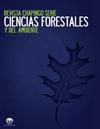赤松发育阶段的碳储存Cham。在伊达尔戈的阿尔塔山脉
IF 0.6
4区 农林科学
Q3 Agricultural and Biological Sciences
Revista Chapingo Serie Ciencias Forestales Y Del Ambiente
Pub Date : 2022-08-30
DOI:10.5154/r.rchscfa.2022.02.009
引用次数: 0
摘要
引言:森林提供与森林生态系统相关的环境商品和服务,如碳固存,这具有促进林业活动盈利和可持续性的市场潜力。目的:估算赤松(Pinus patula Schiede ex Schltdl)发育阶段的生物量和地上碳含量Cham。在伊达尔戈Zacualtipán的ejido Atopixco种植的森林,以了解该物种缓解气候变化的潜力。材料和方法:通过非破坏性方法,使用直接测量乳房高度和直径来估计空中生物量。在每个发育阶段,对取样树木的估计体积乘以基本木材密度,并使用50%的碳系数。结果与讨论:成熟树木的平均生物量为294.8 kg。帕图拉发育阶段的地上碳估计值为:布林扎勒(0.94 Mg C·ha-1)、蒙特布拉沃(3.73 Mg C•ha-1),瓦达卡尔(5.05 Mg C・ha-1)和拉提扎勒(18.18 Mg C‧ha-1)以及福斯塔尔(81.40 Mg C.ha-1)。这种非破坏性的方法可以可靠地估计这种物种的碳含量。结论:帕图拉发展阶段的碳储量量化是一种有用的碳固存环境服务营销策略,在缓解气候变化影响方面具有迫在眉睫的市场潜力。本文章由计算机程序翻译,如有差异,请以英文原文为准。
Carbon storage during the development stages of Pinus patula Schiede ex Schltdl. & Cham. in the Sierra Alta of Hidalgo
Introduction: Forests provide environmental goods and services associated with the forest ecosystem, such as carbon sequestration, which has market potential to contribute to profitability and sustainability of forestry activities. Objective: To estimate biomass and aboveground carbon during the development stages of a Pinus patula Schiede ex Schltdl. & Cham. forest, cultivated in the ejido Atopixco, Zacualtipán, Hidalgo, to know the potential of the species for climate change mitigation. Materials and methods: Aerial biomass was estimated by non-destructive method, using direct measurement of height and diameter at breast height. The volume estimated for the trees sampled, at each stage of development, was multiplied by the basic wood density and the carbon coefficient of 50 % was used. Results and discussion: The average biomass of mature trees was 294.8 kg. Estimates of aboveground carbon at the developmental stages of P. patula were as follows: brinzal (0.94 Mg C·ha-1), monte bravo (3.73 Mg C·ha-1), vardascal (5.05 Mg C·ha-1), latizal (18.18 Mg C·ha-1) and fustal (81.40 Mg C·ha-1). The non-destructive method allowed reliable estimates of carbon content of this species. Conclusion: Carbon storage quantification by stages of development of P. patula is useful marketing strategies of environmental services for carbon sequestration, which has imminent market potential to mitigate the impacts of climate change.
求助全文
通过发布文献求助,成功后即可免费获取论文全文。
去求助
来源期刊
CiteScore
1.20
自引率
16.70%
发文量
0
审稿时长
>12 weeks
期刊介绍:
The Revista Chapingo Serie Ciencias Forestales y del Ambiente (RCHSCFA) is a scientific journal that aims to raise awareness of high-quality research products related to forest, arid, temperate and tropical environments in the world. Since its foundation in 1994, the RCHSCFA has served as a space for scientific dissemination and discussion at a national and international level among academics, researchers, undergraduate and graduate students, forest managers and public/private entities that are interested in the forest environment.
All content published in the journal first goes through a strict triple-blind review process and is published in the following formats: Scientific Articles, Review Articles, Methodologies, Technical or Technological Notes.

 求助内容:
求助内容: 应助结果提醒方式:
应助结果提醒方式:


